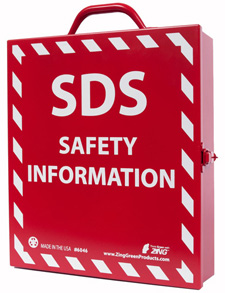



Find all of your laboratory and workplace safety supplies at Safety Emporium!
 WGK |
 Glossary Index |
 Wilson RISK Scale |
| MSDS Topics |
Free Sites | FAQ's | Regulations | Glossary | Software | Suppliers |
| Books | Forum | Poll | Fun stuff | Quiz | Store | |
| Understand your MSDS with the MS-Demystifier | Search ALL our MSDS info | |||||

Your employees can stay informed and comply with OSHA regulations with SDS information stations and compliance products from Safety Emporium.
The Workplace Hazardous Materials Information System (WHMIS) or Système d'information sur les matières dangereuses utilisèes au travail, (SIMDUT) in French, is Canadian legislation covering the use of hazardous materials in the workplace. This includes assessment, signage, labeling, Safety Data Sheets and worker training. WHMIS closely parallels the U.S. OSHA Hazard Communication Standard.
Do not confuse this with HMIS®, a hazard/label system of the American Coatings Association (formerly called the National Paint and Coatings Association).
Most of the requirements of WHMIS are incorporated into Canada's Hazardous Products Act and Controlled Products Regulations which are administered by Health Canada. Certain provincial or territorial laws may also apply. Enforcement of WHMIS is performed by the Labour Branch of Human Resources Development Canada or the provincial/territorial OHS agencies. Together, these various agencies have created one comprehensive resource portal, WHMIS.org which are your go-to source for official WHMIS information.
Worldwide workplace safety standards evolved during the early 2000's with the advent of a United Nations effort called the Globally Harmonized System of Classification and Labeling of Chemicals (GHS) which established a worldwide model framework so that various trading partner countries could establish substantially similar requirements for classifying chemical hazards, labeling containers, and communicating hazards via Safety Data Sheets (SDSs). As a result, most countries of the world now use the same format for SDSs, although there are differences in the precise implementation of the model regulations among various countries.

Get your GHS-compliant labels and signs from Safety Emporium.
Canada formally adopted the GHS model framework in its lastest update, WHMIS 2015, which rendered WHMIS 1998 obsolete on December 1, 2018. WHMIS 1988 labels and safety data sheets should no longer be used in the workplace. Some of the key changes which took effect with WHMIS 2015 include:
While these changes were considerable, the roles and responsibilities under the now-obsolete WHMIS 1998 system still apply.
Within the WHMIS framework, chemical products with proprietary formulations or trade secret hazardous ingredients must be registered under the Hazardous Materials Information Review Act before thay can be sold or distributed in Canada. Registration numbers under this Act are issued by the Hazardous Materials Information Review Commission (HMIRC). HMIRC is an independent government administrative law agency rather than being directly a part of Health Canada.

Encourage safety on the job with electronic safety scoreboards from Safety Emporium.
WHMIS 1998 was replaced by WHMIS 2015 which is based on the Globally Harmonized System and is no longer in use. The information in this section is obsolete and is presented solely for historical purposes. WHMIS 1998 had six broad hazard classifications:
The Controlled Products Regulations (CPR), prescribed what information must be on labels and (what were then called MSDSs but are now simply SDSs) under WHMIS 1998. You can find the 9 required parts as well as information on how one was to write an MSDS on this CCOHS web page [NOTE: This is OBSOLETE information, presented here only for reference purposes].
All materials covered by WHMIS are required to have Safety Data Sheets. This means that every worker must have an SDS for each hazardous substance and be trained in working with that material.
As discussed above, the Canadian implementation of the GHS model standard differs from other countries, so there may be variations between SDS's and labels from country to country. For example, the US's HCS 2012 is based on GHS Revision 3 whereas WHMIS is based on GHS Revision 5. In 2021, OSHA announced proposed rulemaking to align HCS with GHS Revision 7, an effort that would also reconcile aspects with WHMIS 2015. As of 2022, the most significant differences between HCS 2012 and WHMIS 2015 include:

Get your PPE such as made in USA NIOSH-approved N95 masks from Safety Emporium.
See also: The MSDS FAQ- Canadian MSDS's, OSHA
Additional definitions from Google and OneLook.
Entry last updated: Sunday, March 20, 2022. This page is copyright 2000-2025 by ILPI. Unauthorized duplication or posting on other web sites is expressly prohibited. Send suggestions, comments, and new entry desires (include the URL if applicable) to us by email.
Disclaimer: The information contained herein is believed to be true and accurate, however ILPI makes no guarantees concerning the veracity of any statement. Use of any information on this page is at the reader's own risk. ILPI strongly encourages the reader to consult the appropriate local, state and federal agencies concerning the matters discussed herein.